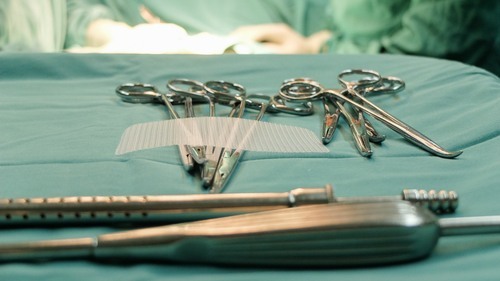Mesh migration is a possible complication of hernia repair surgery. Not only is it a painful experience, but it is also a cause for other complications and injuries.
If the mesh used in the repair surgery was defective and thus the reason for the mesh migration, you may be entitled to file a lawsuit as to the hernia mesh injuries. Here’s what you need to know about mesh migration.
- 1. What is mesh migration?
- 2. What complications are caused by implant migrations?
- 3. What are the symptoms or signs of mesh migration?
- 4. How is migration diagnosed?
- 5. Will you need to have another surgery?
- 6. Are there mesh products more known to migrate than others?
- 7. When should you contact a personal injury lawyer?

1. What is mesh migration?
Mesh migration is a medical condition that happens when mesh used to repair things like hernias move from its intended spot to another location. This process could be immediate or could occur over time. There are two circumstances that generally lead to mesh migration: (1) mechanical migration; and (2) secondary migration.
Mechanical (or Primary) Migration. Mechanical migrations happen when mesh is inadequately secured to surrounding tissue and, due to its unanchored status, it begins to move. In some instances, the mesh could have been initially secured to surrounding tissue, but an undue pressure by an external force causes the mesh to separate and move. This type of migration often happens sooner after the surgery as opposed to later.
Secondary Migration. When the body has an inflammatory reaction to the mesh implant, the body creates granulation tissue at the location of the implant. Granulation tissue is bumpy, pink connective scar-like tissue that forms at the place of a wound. The problem is: this healing process stimulates mesh erosion. As the mesh erodes, it shrinks and may then start to migrate. This type of migration happens slowly over months and years as the inflammation breaks down the foreign mesh material.
2. What complications are caused by implant migrations?
The complications of mesh migration can vary greatly, depending on the location and type of mesh product. Generally speaking, this condition can cause
- Unusual and serious bleeding
- Infection
- Fistula formation
- Hernia recurrence
- Chronic pain. 1
In the most severe of migration cases, the device may become free of any tissue, wrinkle, and/or fold up into a clumpy ball. This clumpy ball is known as meshoma. It can have an abrasive effect on surrounding tissue that can lead to nerve damage and debilitating chronic pain. These injuries could require extensive long-term pain management.
Mesh that has migrated to specific organs, like the bladder or scrotum, can cause additional and unique complications.
2.1 What happens if the implant moves into the bladder?
If a mesh device migrates into the bladder, serious health problems can arise, like
- Hematuria, which is the presence of red blood cells in urine
- Recurrent urinary tract infections.
This type of migration often happens after laparoscopic repair of an inguinal hernia, 2 but it also occurs after open ventral hernia repair surgery 3.
2.2 What happens if the implant moves into the scrotum?
Mesh migration into the scrotum also has serious health consequences, like
- Tenderness
- Organ perforation
- Organ strangulation
- Bowel obstruction.
3. What are the symptoms or signs of mesh migration?
The symptoms or signs of mesh migration are similar to mesh failure symptoms, which includes
- Bloating and/or an inability to pass stools or gas
- Fever when its cause is unknown
- Chills, nausea, and/or vomiting
- Warm or hot skin where the incision occurred
- The wound from surgery is not healing in due time
- Fluid buildup at the site of the surgery, known as seromas
- Bulging in the area of the hernia
- Mild to severe pain
- Chronic pain.
Basically, if you have had hernia repair surgery with mesh anytime in the past and you have any of these symptoms, you want to see your doctor about it.
4. How is migration diagnosed?
Diagnosis is difficult and cannot be accurately made without the use of x-rays or a CT scan or other imaging process. If you have symptoms of mesh failure, you need to consult with your doctor immediately. At that time, your doctor should examine you thoroughly and decide if x-rays or other tests are appropriate.
5. Will you need to have another surgery?
Yes. When the implant migrates or erodes, you will need surgery to remove the defective product — or what’s left of it — and the surrounding scar tissue. Surgery will also be necessary to correct any other complications caused by the mesh migration, like bowel obstruction or hernia recurrence.
6. Are there mesh products more known to migrate than others?
All implants are capable of migrating if either of the above-noted two circumstances (primary or secondary migration) exist. There have, however, been lawsuits filed specifically due to mesh migration. Those lawsuits have included the following two mesh products:
- Atrium C-Qur Edge 4
- Ethicon Physiomesh. 5

7. When should you contact a personal injury lawyer?
If you have had hernia repair surgery and subsequently suffered mesh migration, you may wonder why it happened to you. Know that you are not alone. And know that you have rights. If you have been injured due to a defective product, then you are entitled to file a claim or lawsuit for compensatory damages.
At Shouse Law Group, our personal injury lawyers have years of experience. We have local offices throughout California but represent clients throughout the U.S. in hernia mesh claims. Contact our office today to discuss the specifics of your case.
References
- Talve, Michael. Synthetic Mesh Defect and Migration Causes Severe Abdominal Infection and Fistula Formation. The Expert Institute. November 11, 2013.
- Agrawal, A., Avill, R. Mesh migration following repair of inguinal hernia: a case report and review of literature. Hernia. March 2006, Vol. 10, Issue 1, pp. 79-82.
- Su, Yann-Rong and Chan, Pei-Hui. Mesh migration into urinary bladder after open ventral herniorrhaphy with mesh: A Case Report. Int Sur. 2014 Jul-Aug; 99(4): 410–413. doi: 10.9738/INTSURG-D-13-00037.1 See also, Novaretti, J.P.T., Cotrim, C.A.C., Denadai, Rafael,Souto, Luis. Migration mesh mimicking bladder malignancy after open inguinal hernia repair. Hernia. December 2010, Vol. 16, Issue 4, pp. 467-70.
- Lott et al. V. Atrium Medical Corporation et al. Case Filed: February 5, 2018. Case No. 1:13-cv-00111. U.S. District Court for the District of New Hampshire.
- In RE: Ethicon Physiomesh Flexible Composite Hernia Mesh Products Liability Litigation. Case No. 1:17-md-02782-RWS. U.S. District Court of the Northern District of Georgia.
